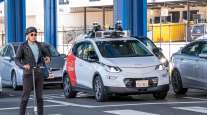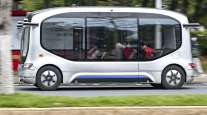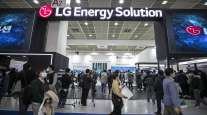General Motors Says Self-Driving Taxi Fleets Coming in 2019

Big fleets of robot taxis — with no backup drivers — from General Motors could hit the streets of San Francisco and other cities in less than two years, the company said Nov. 30.
The cars initially will be able to offer rides at a cost of about $1.50 a mile, quickly getting to $1 a mile, whereas current ride-hailing services cost about $2 or $3 a mile, GM said.
The 109-year-old company considers driverless vehicles the biggest business opportunity since the creation of the Internet. Electricity-powered robot taxis — along with new revenue streams such as selling data they generate — could quickly eclipse GM’s current business of manufacturing and selling cars to consumers and companies, executives said.
RELATED: GM buys lidar startup Strobe to accelerate self-driving cars
“GM is committed to a future where we have zero crashes, zero emissions and zero congestion,” said CEO Mary Barra, in a presentation to Wall Street investors, analysts and journalists in San Francisco.
Driverless technology has long been a dream for GM: At the 1939 World’s Fair in New York, the company worked with a famous designer to create a 3-D display of a city of the future, with cars propelled by “automatic radio control.” In the 1950s, a Firebird III concept car with a dashboard “Autoguide” button was used to test a “smart highway,” which was wired to keep cars on the road.
For now, however, “the question is: ‘Can GM deliver, and does Wall Street believe it?’” said Michelle Krebs, executive analyst for Autotrader.
RELATED: It’s no use honking. The robot at the wheel can’t hear you
Currently, all self-driving cars in San Francisco, including GM’s, operate with a backup driver — as is required by California law.
But California has been moving quickly to update its laws. “We don’t see (regulations) as an impediment to wide-scale deployment,” GM President Dan Ammann said.
GM’s presentation took place blocks away from the South of Market offices of Cruise Automation, which GM bought last year for over half a billion dollars and made the cornerstone of its self-driving thrust. Cruise had 40 employees then; it now has 400. In all, 1,200 people at GM work on self-driving cars.
“Large automakers typically aren’t so bullish with their announcements, so GM likely recognizes the opportunity to establish leadership by committing to this very specific short-term goal,” said Jessica Caldwell, executive director of industry analysis at Edmunds.com. To date, many autonomous-vehicle pronouncements have been “somewhat riddled with hazy promises,” she added.
Plenty of other companies, including startups and tech giants as well as major automakers, are aggressively pursuing the same goal as GM. Waymo, a unit of Google parent company Alphabet and the chief pioneer of driverless-car technology, plans soon to offer rides without a safety driver to passengers in Arizona. Ride-hailing service Uber has been testing robot taxis with backup drivers for a year. Palo Alto’s Tesla, too, envisions an eventual fleet of ride-hailing vehicles and has rolled out semiautonomous software for current drivers.
Making driverless cars safe, scalable, and able to operate in complex environments is no trivial matter.
“The engineering challenge to get to a commercial launch is perhaps 10,000 times more difficult than doing a simple (autonomous vehicle) demo of a car driving around the block,” Ammann said.
It helps that the technology is self-learning. “This product will continuously get better from the moment it’s launched; the more you use it, the better it will get,” Ammann said.
Cruise has built 180 test vehicles, about 100 of them operating in San Francisco, which it describes as one of the most challenging driving environments. That helps the cars learn faster, the company said. It plans tests in Manhattan, the country’s other most challenging city, next year.
“We are on a path to be up to a million miles a month of on-road testing in 2018,” said Cruise CEO and co-founder Kyle Vogt.
Cruise developed technology to create high-definition digital maps and then use data from its cars to keep them current. “You can having living, breathing, self-healing maps that are up to date in any core market,” Vogt said.
Besides giving rides, the robot cars might ferry packages when passenger demand is lower, Ammann said.
Despite having invested $500 million for a 9% stake in Lyft, GM was curiously silent on what role, if any, the San Francisco ride-hailing company might play. In response to a question about Lyft, Ammann said GM has many options in how it goes to market.
GM followed the Nov. 30 presentation by offering rides around the city in Cruise’s autonomous Chevy Bolts to Wall Street investors who’d flown in for the event. But similar Cruise test drives on Nov. 28 were described by riders as jerky. “The overall quality of the ride was lacking in refinement,” Edmunds’ Caldwell said. Cruise said that is because it’s concentrating on the hardest problems, such as safety and redundant systems.
“Once we’ve done that, we can focus on the easier parts of the problem: take the edge off the ride to make it smooth, (and) shave a few seconds off here and there; the entertainment, the prettier and glossier part,” Vogt said. Other companies are approaching the problem backward, he said, producing “concept cars that are all about flash.”
Distributed by Tribune Content Agency, LLC




